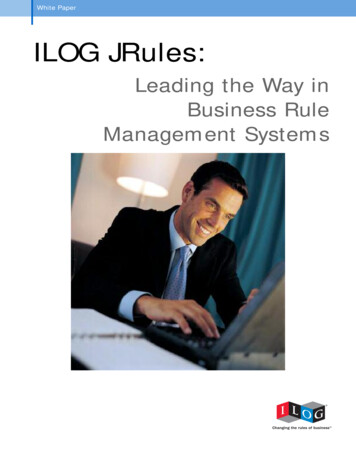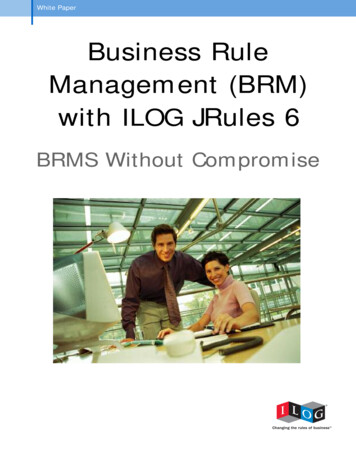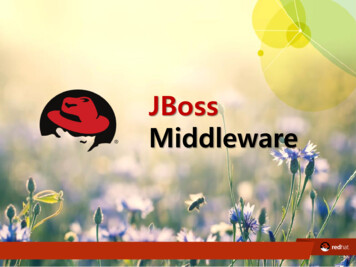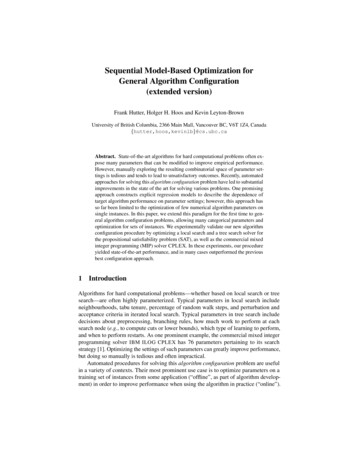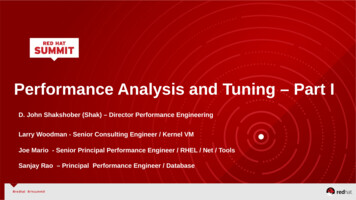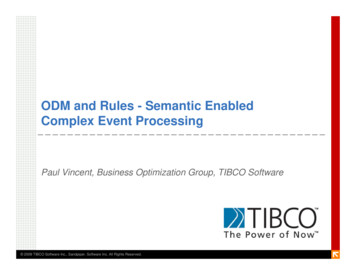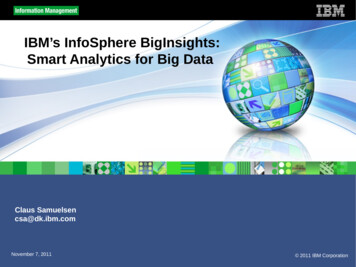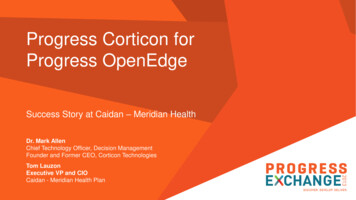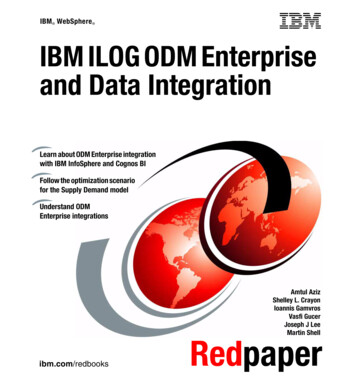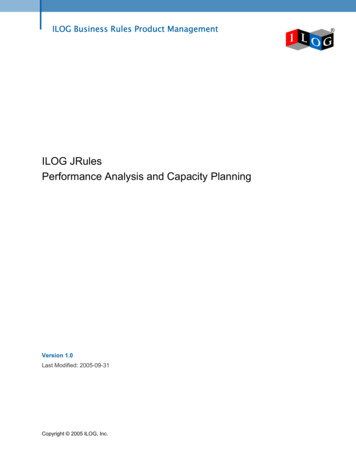
Transcription
ILOG Business Rules Product ManagementILOG JRulesPerformance Analysis and Capacity PlanningVersion 1.0Last Modified: 2005-09-31Copyright 2005 ILOG, Inc.
ILOG Business Rules Product Management IntroductionJRules customers and evaluators often ask fundamental questions such as: “How fast is the rule engine?”, “Howmuch memory does it require?”, “How many CPUs will I require to execute 1,000 rules per second?”, “What is thebest JVM to use with JRules” etcetera.For a product like JRules these questions turn out to be very difficult to answer in a genuinely useful way. Whenyou view the rule engine as a general-purpose execution mechanism for an arbitrary set of program statements, itbecomes clear that the most influential factor in answering all of these questions is the contents of the rule engine(rules and working memory) while under test. This is of course no different to many other software components,such as the Java Virtual Machine itself. However this rather flippant answer is obviously not helpful to architectsperforming capacity planning or trying to understand the impact of JRules on the complex architectural trade-offsthey have to make.Capacity planning is not an exact science. Every application is different. This document is intended as a guide fordeveloping capacity planning numbers and encourages you to err on the side of caution. In particularly the rulesused for this capacity-planning document will not be representative of the rules in your application.Any and all recommendations generated by this guide should be adequately verified before a given system isplaced into production. There is no substitute for adequately testing a prototype for capacity planning numbers.1 Academic BenchmarksIt is briefly worth mentioning the academic benchmarks, such as Manners, Waltz or Fibonacci. In most casesthese benchmarks test worst-case Rete-algorithm agenda usage, and are not very representative of mosteBusiness applications. While they may be interesting from an academic and learning perspective they generallyare a fairly poor predictor of real-world application performance.2 Sample Rule Engine ResultsThe table below shows a range of benchmark results obtained with code based on shipped JRules code samples.The examples vary in profile from memory intensive, Rete algorithm intensive, sequential algorithm specific,through to XML processing using rules. The table is intended to give you a general sense for the type of out-ofthe-box performance you can achieve with JRules. In most cases these results could be improved upon using theoptimization techniques described later in the paper.ConfigurationOperationWorkingMemoryRulesDell D600. SUN1.5.0 01 JVMRules are evaluated against all input objects.1 million objectsaccessed usinga collect7 rules, withfunctionsand ruleflowDell D600. SUN1.5.0 1 JVMRete algorithm with complex pattern matching 500 objectsrules. Incremental updates triggered byassert/update/retract with dynamic schedulingusing refraction, priorities, and recency.Copyright 2005 ILOG, Inc.AverageEvaluationTime (ms)52315 rules, twofunction310
ILOG Business Rules Product Management ConfigurationOperationWorkingMemoryRulesDell D600. SUN1.4.2 03 JVMSequential mode used to evaluate simplerules against a single input parameter. Theruleset uses dynamic select to optimize theset of rules to evaluate based on thecharacteristics of the incoming data.1 inputparameter6000 rulesILOG XML binding used to process twoincoming XML documents (an order and acustomer) using some BAL rules and a 400row decision table.Two incomingXML documents(with differentschema)2x Xeon, RHEL2.4.9-e.49smp.BEA 1.4.2 04JVMAverageEvaluationTime (ms)6400 rowdecisiontable, plusBAL rules.33 Business Rules, Algorithms and TuningAs mentioned earlier, the most important factors in determining the performance of the rule engine are thebusiness rules and data that you put into the rule engine. There are a number of guidelines and configurationoptions that can be used to maximize the performance of the rule engine.3.1Structure of RulesThe conditions of rules should be as similar as possible. The JRules implementations of the Rete and Sequentialalgorithms both analyze the structure of the conditions of a rule and can share condition tests. Decision Tablesand Decision Trees will have this property automatically, ensuring that repetitive tests shared between many rulesare optimized.3.2Number of RulesJRules can execute a very large number of rules. Using the Sequential algorithm in particular, rules can easilynumber into the hundreds of thousands. As the number of rules increases the rules may need to be examinedmore closely for potential performance issues and carefully orchestrated using Ruleflow. With large numbers ofrules, issues such as parsing time for the ruleset and memory footprint may become factors worthy of specificbenchmark studies.3.3Executable Object ModelAll code called from the conditions of rules should be optimized. The conditions of a rule may be invoked manytimes depending on the data in working memory.The actions (the “Then” part) of business rules should execute as quickly as possible. Avoid performing highlatency tasks inside the rule engine if it can be avoided. These tasks may be invoked more frequently thanexpected, particularly as applications evolve and the contents of working memory changes.Copyright 2005 ILOG, Inc.
ILOG Business Rules Product Management3.4 RuleflowsUsing a Ruleflow to segment and control rule execution is a very good technique to not only create moremaintainable rule projects, but also to improve performance. The execution algorithm (see below) can bespecified at the Rule Task level, allowing you to mix Rete-based inference tasks with Sequential algorithm tasks,while sharing state between them using ruleset parameters.In addition, using static or dynamic select allows you to create Rule Tasks that contains lists of rules that arespecified at authoring or runtime. This allows you to compute the subset of rules to be evaluated; even postponingthis decision until the runtime input parameters are assigned and known. These highly focused rule tasks ensurethat rules that should never be fired are not present in the task definition. Such an approach should generally befavored over using an agenda filter for example, where rules that have been matched are programmaticallyprevented from firing using a ruleset function or Java code.3.5Execution ModeJRules implements two rule evaluation algorithms: the Rete algorithm for inference-based problems and theSequential algorithm for applying a list of rules sequentially to a set of input objects.The choice of evaluation algorithm is an architectural decision that typically has an impact on how you choose tostructure your rules project and develop a rule-based solution. In addition the evaluation algorithm may have animpact on runtime execution performance, parsing time and memory requirements. A detailed description of thedifferences between the Rete and Sequential algorithms is includes within the JRules documentation under: Application Development Implementation Rule Engine Sequential Processing Comparing theRete and the Sequential Algorithms10,000 Rules - Setup4500040000Time (ms)350003000025000Create RulesetCreate oFigure 1 Parsing and IlrContext creation time. Dell D600, Windows XPFigure 1 shows the time required to parse a ruleset with 10,000 rules and then create an executable IlrContextrule engine instance. The parsing time is dominated by the detection of conditions that can be shared betweenrules (which is a key benefit of the Rete graph). Therefore disabling Rete sharing detection reduces parsing timefor Rete algorithm rulesets, however some of the benefits of Rete are lost. In situations where it is known that littleor no sharing is present however this may be a useful optimization. The Sequential algorithm has a simplerparsing and context creation code path; however more work is performed at the first ruleset execution.Copyright 2005 ILOG, Inc.
ILOG Business Rules Product Management 10,000 Rules - Execution600Time (ms)500400First Run300Avg. ReteSequentialReteruleflowScenarioFigure 2 First and Average execution time. Dell D600, Windows XPFigure 2 shows the runtime execution times for a 10,000-rule ruleset in six sample execution modes. The graphillustrates the high cost of the first sequential mode execution, while the Just-In-Time transformation from theILOG Rule Language to Java byte code takes place. This is typically a one time cost however, if IlrContextpooling, as implemented by the JRules Business Rule Execution Server is used.Copyright 2005 ILOG, Inc.
ILOG Business Rules Product Management 3 . 5 .1 R e t e A lg orit hmCreate Ruleset, Rete Algorithm4000035000Time 5000600070008000900010000Number of RulesFigure 3 Parsing scalability for Rete ruleset. Dell D600, Windows XPFigure 3 shows the scalability of the parser for Rete mode rulesets. Parse time can become a significantconsideration (37.5 seconds for 10,000 rules) reinforcing the importance of a reliable caching strategy for parsedrulesets, such as offered by the Business Rule Execution Server (see below).Create Context, Rete Algorithm700Time 080009000Number of RulesFigure 4 IlrContext creation time for Rete ruleset. Dell D600, Windows XPCopyright 2005 ILOG, Inc.10000
ILOG Business Rules Product Management As Figure 4 shows, creating an IlrContext from a parsed Rete ruleset is rarely a performance issue, showingapproximately linear scalability and a creation time of less than 650ms for a ruleset with 10,000 rules.Average Run, Rete Algorithm4035Time 0010000Number of RulesFigure 5 Average Execution Time, simple Rete rules. Dell D600, Windows XPFigure 5 shows the high performance of the JRules Rete engine, capable of evaluating 10,000 simple Rete rulesin just over 35 ms. The rete-ruleflow scenario was used, and the test run on a Dell D600 with Sun MicrosystemsJDK 1.5.3 .5 .2 Se que nt ia l A lg or ith mThe JRules Sequential algorithm is a very fast mechanism to apply a list of rules to a list of input objects. TheSequential algorithm always executes as Java byte code (generated using ILOG's Just-In-Time compiler) offeringthe best execution on modern optimizing Java Virtual Machines. The JRules Sequential algorithm is particularlyfast on the Sun Microsystems Hotspot JVM.Copyright 2005 ILOG, Inc.
ILOG Business Rules Product Management Create Ruleset, Sequential Algorithm120000Time 005000060000700008000090000 100000Number of RulesFigure 6 Parsing time for sequential mode rulesets. Dell D600, Windows XPWhile parsing Sequential algorithm rules the rule engine does not have to build the complex Rete network.Sequential mode therefore also benefits from improved parsing times when compared to Rete (with conditionsharing detection enabled). Figure 6 illustrates that 100,000 sequential mode rules can be parsed in less than 2minutes and that the parsing time varies linearly with the number of rules.First Run, Sequential Algorithm100009000Time 000400005000060000700008000090000100000Number of RulesFigure 7 JIT Compilation time for Sequential algorithm rules. Dell D600, Windows XPCopyright 2005 ILOG, Inc.
ILOG Business Rules Product Management The first time a Sequential algorithm ruleset is executed the rules are Just-In-Time compiled to Java byte code.For large numbers of rules this can take several seconds as many classes may be generated, with each classcontaining many methods. These classes have to be verified and loaded by the JVM. This is typically a one-timeoperation however, as the generated byte code will be stored within the IlrContext instance, which in the case ofdeployment using the BRE Server, is itself cached.Average Run, Sequential Algorithm4540Time r of RulesFigure 8 Average execution time for Sequential algorithm rules. Dell D600, Windows XPSubsequent execution of Sequential algorithm tasks is very fast and varies approximately linearly with the numberof rules. As can be see in Illustration 8, 100,000 simple Sequential algorithm rules can be evaluated in less than40 ms.3.6Autohashing, Hashers and FindersDefining Hashers and Finders for a ruleset data model is a very powerful way to further optimize rulesetexecution. Hashers can be used to optimize equality conditions between model elements while Finders are usedto optimize navigation through the object model by introducing domain specific knowledge into the rule engine.These optimization techniques are described in the JRules documentation under: Rule Engine Optimization TechniquesThe BR Studio rule engine-tuning example improves the performance of a ruleset by a factor of more than 6, bycareful analysis of the structure of the ruleset and the runtime behavior of the ruleset.3.7Rete TuningThe Just-In-Time (JIT) byte code compilation feature for Rete mode can be used to optimize the evaluation ofconditions of rules. When JIT is enabled JRules will call methods in the conditions of rules using generated bytecode, rather than using the Java reflection APIs. The time to create an IlrContext from an IlrRuleset is increasedCopyright 2005 ILOG, Inc.
ILOG Business Rules Product Management when the JIT is enabled, however this is a one time cost for pooled IlrContext instances, and should not be ofconcern. The JIT can be activated whenever the rule engine has the security permissions to create a customClassLoader.3.8Sequential Algorithm TuningThe Sequential algorithm optimizations consists of providing automatic caching for the tests and the values of thecondition parts of rules, so that similar expressions will not be computed twice during the sequential application ofthe rules to a tuple of objects.With test caching turned on, tests of different conditions that are related, even in different rules, will share acommon test value register at runtime that will be computed only once for a given tuple of objects. The level oftest analysis for sequential mode can be specified using deployment properties. The most powerful test analysiscan go beyond equivalence and is able to identify such things as two tests that are the complement of each otheror the fact that a test subsumes another test.3.9Minimizing Parsing TimeTo minimize the parsing time for large rulesets, use the Sequential algorithm or use the Rete algorithm with theflag ilog.rules.engine.useReteSharing set to false. This flag disables the expensive condition analysis that isperformed while building the Rete network. It will result in a Rete network with no condition sharing however, sothis flag should be used with care as it can have a significant performance impact.4 Invoking the Rule EngineIn general terms, for high performance systems, architects favor a stateless execution model. This allows foreasier load-balancing, horizontal scalability, and in the special case of idempotency, for failed transactions to beretried in the event of failure under load, or for disaster recovery.A message based invocation pattern (using the Message Driven Bean supplied with the BRE Server for example)can also perform extremely well and also provides easy horizontal scalability and good scalability under peak loadconditions. The Java Message Service provider used by the Message Driven Bean can also assure guaranteeddelivery of messages and other quality of service contracts for high performance and highly-available systems.4.1Ruleflow Task RunnersFor some applications, maintaining the state associated with a Ruleflow may be unnecessary. If a given task in aRuleflow needs to be executed many times, with maximum performance the Ruleflow mechanism can bebypassed and a single Sequential task can be directly executed by API.This advanced optimization technique is described in the documentation here: Rule Engine Optimization Techniques Rule Task RunnersAlthough for some use cases the performance advantages may merit such an approach, Task Runners shouldnot be used indiscriminately – as they complicate the deployment, maintenance and orchestration of rules.Typically the control or rule orchestration logic moves from within the ruleset to within Java code, resulting in anoverall loss of visibility into how the rules are fired. Task runners cannot be used with the BRE Server.Copyright 2005 ILOG, Inc.
ILOG Business Rules Product Management 5 Hardware and Operating SystemsFor simple single-threaded, CPU intensive JRules micro-benchmarks, single processor machines with a highclock-speed generally outperform multiple processor machines with slower clock speeds. On real-worldapplications (which typically perform significant I/O operations for network or data access) clustered machinesand multi-CPU machines with server optimized JVMs and Operating Systems are to be preferred. Quality ofservice, availability, robustness under stress conditions and manageability should also be weighted against rawperformance when selecting an execution environment.6 Java Virtual MachinesJava Virtual Machines evolve very quickly and all have different performance characteristics. In addition JVMssupply a wide array tuning capabilities (particularly for memory management) that may have a considerableimpact upon general Java performance. Please refer to the detailed documentation for your JVM for more details.7 Memory UsageThe table below shows the approximate memory usage for several JRules execution scenarios. The memoryrequirements are mostly independent of the execution mode and varied between 2.37 Kb and 4.12 Kb per rule,runtime memory commit. This figure will vary considerably however depending on the number and complexity ofthe rule properties (metadata) and the degree of sharing in the conditions of the rules. The scenarios using JITshow higher JVM memory consumption due to the generated Java classes.Memory usage was measured using the Sun Microsystems JVM and the new JDK 1.5 JMX MBeans for memorymonitoring. The configuration tested was JDK 1.5.0, JRules 5.1, Dell D600, Windows XP.ScenarioTotal Benchmark UsedMemoryTotal Benchmark UsedMemory(1 rule)(10,000 51.9940.21Memory Delta(MB)8 Deployment to a J2EE Application ServerIn general the J2EE application server should be tuned for the deployed application and the expected peak oraverage load. Generally speaking this includes items like:Copyright 2005 ILOG, Inc.
ILOG Business Rules Product Management Number of request threads Number of execute threads Size of EJB pools Size of JCA pools Using native I/O or pure Java I/O Pool reclamation policy Data replication strategy for clustered deployments You should refer to the detailed tuning guide for your application server for specific information related to yourenvironment.9 Using the ILOG Business Rule Execution ServerThe BRE Server is a complete execution and management environment for business rule applications. It providesa number of features that are required for high performance, scalable and manageable applications: Pooling of rulesets and contexts Hot deployment of rulesets File and database persistence of deployed rulesets Web-based system administration console Runtime monitoring of execution using the Java Management Extensions (JMX) API Client APIs: stateless Plain Old Java Object (POJO), stateful POJO, stateless EJB, stateful EJB andMessage Driven EJB for asynchronous invocationBy deploying the BRE Server (for J2EE or J2SE applications) your business rules applications automatically takeadvantage of the execution and management services offered by JRules and you avoid having to implementruleset and context pooling within your application code. Your overall application build and deployment processescan also integrate the Ant tasks ILOG provides for the BRE Server.9.1Tuning the BRE ServerSome simple tuning tips for the BRE Server: The log level of the BRE Server Execution Unit should be set to WARNING (the default mode is INFO) byediting the Resource Adapter XML deployment descriptor. If the Message Driven Bean is being used,disable trace messages by editing its deployment descriptor. Typically this will give a performance gain of25%-50% over the default, more verbose, configuration. RuleApps, rulesets or ruleset tasks should not be deployed with debugging enabled unless debugging isbeing used. XU Plugins should only be registered with the BRE Server Execution Unit when necessary. If XU Pluginsare used, be very aware of the performance impact of code within the plugin callback method as thecallback will be invoked very frequently during execution. For J2SE deployments the Execution Unit pool should be sized appropriately: the size should be greaterthan the number of concurrent requests.Copyright 2005 ILOG, Inc.
ILOG Business Rules Product Management In J2EE deployments the XU Resource Adapter should be configured (at the Application Server level) toset the number of XU connections appropriately to avoid excessive synchronization of requestprocessing. The recommended settings will depend on the number of CPUs available to the applicationserver and the number of execute-threads configured. In addition, if stateful or stateless EJBs are beingused to invoke the BRE Server the maximum size of the pools for the EJBs should also be appropriatelysized.The Message Driven Bean (MDB) is an easy mechanism to achieve high-performance, easily clustered andscalable execution of rulesets. Figure 9 shows the results of invoking a ruleset 100,000 times through the MDB.The ruleset invoked contained 10,000 simple Sequential algorithm rules.The configuration used was: JMS Server: JBoss 4.0.1 running on 2x CPU Xeon, with hyper-threading, 2 GB RAM, Linux configurationrunning RHEL 2.4.9-e.49smp JMS Client: Dell Latitude D600, Windows XP SP2, 1 GB RAM. 10,000 simple Sequential algorithm rules JRules 5.0The results obtained were: Client processed 10,000 JMS messages in 94,946 ms Client side transactions per second: 105 Average client side processing time per message: 9.5 ms Average server side processing time per message: 8.5 msCopyright 2005 ILOG, Inc.
ILOG Business Rules Product ManagementFigure 9 BRE Server console showing the results of 100,000 calls to a ruleset.10 ConclusionsILOG JRules offers a rich variety of high-performance and scalable services for demanding eBusinessapplications. The mature and highly optimized Rete and Sequential rule evaluation algorithms, coupled with thecaching and management services of the BRE Server, ensure that solutions incorporating business rules can bedeployed quickly and effectively. As can be seen from figure 10, in many cases the time taken to evaluatethousands of business rules may be less than that required for a simple database query.Copyright 2005 ILOG, Inc.
ILOG Business Rules Product Management Ruleset Evaluation TimeDell D600, Windows XP, Sun JDK 1.5 JVMRete AlgorithmSequential Algorithm403530Time 10000Number of RulesFigure 10 The JRules Rete and Sequential rule evaluation algorithms exhibit excellent performance andscalabilityOnce solutions are deployed to a staging environment, architects may choose to exploit the powerful JRulesoptimization features to further tune applications, based on target service level agreements. The highperformance coupled with the flexibility of JRules makes it equally suitable for intensive J2EE online transactionprocessing systems, integration with message-oriented middleware or high-volume J2SE batch processingapplications.If you have additional questions, training requirements, or would like hands-on application design or tuningassistance, please contact your local sales representative or access the ILOG website at http://www.ilog.com.11 ReferencesWebLogic Capacity ndex.htmlMP16: WebSphere MQ for z/OS - Capacity planning & tuninghttp://www.ibm.comIP03: WebSphere MQ Integrator - Capacity planning toolhttp://www.ibm.comCopyright 2005 ILOG, Inc.
ILOG Business Rules Product ManagementIBM Training: WebSphere Application Performance Sizing and Capacity Planning for iSeries servershttp://www.ibm.comPerformance Analysis for Java Web Sites by Joines, Willenborg, and HyghISBN 0201844540Publisher: Addison-Wesley ProfessionalJ2EE Performance Testing by Peter Zadrozny, Philip Aston, Ted OsborneISBN: 159059181XPublisher: ApressAnatomy of a flawed micro benchmark by Brian brary/j-jtp02225.html?ca drs-j0805Copyright 2005 ILOG, Inc.
options that can be used to maximize the performance of the rule engine. 3.1 Structure of Rules The conditions of rules should be as similar as possible. The JRules implementations of the Rete and Sequential algorithms both analyze the structure of the conditions of a rule and can share condition tests. Decision Tables
